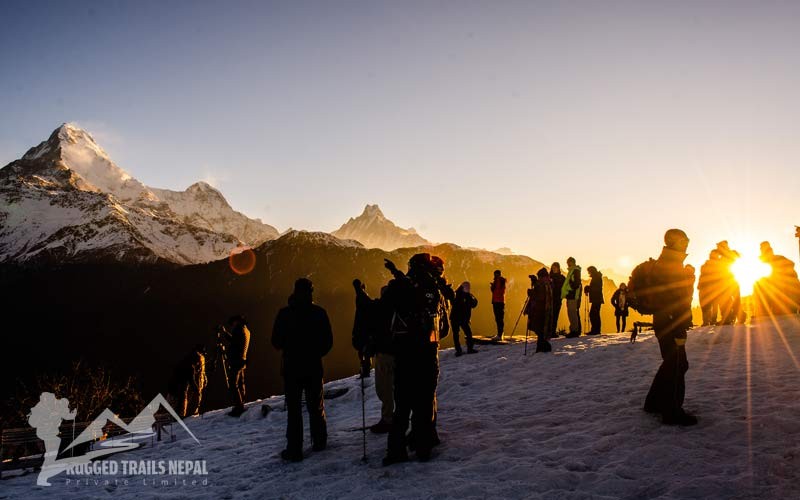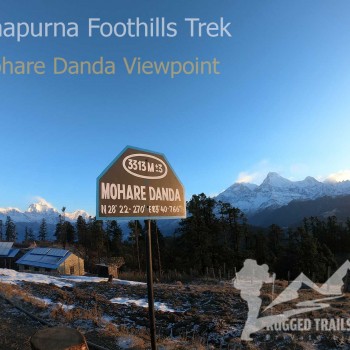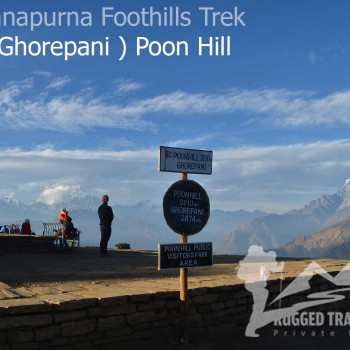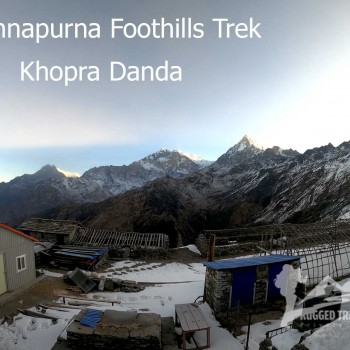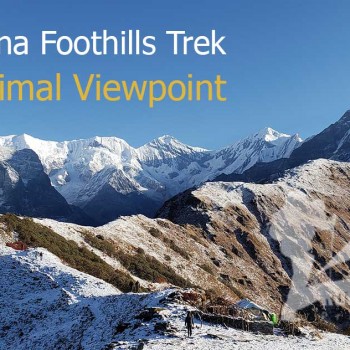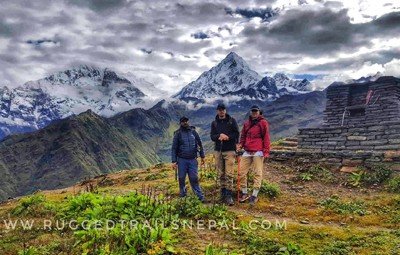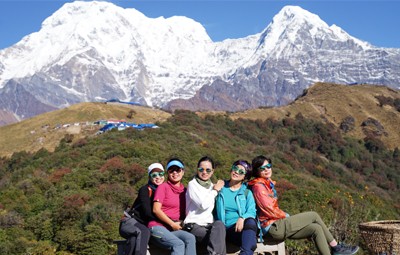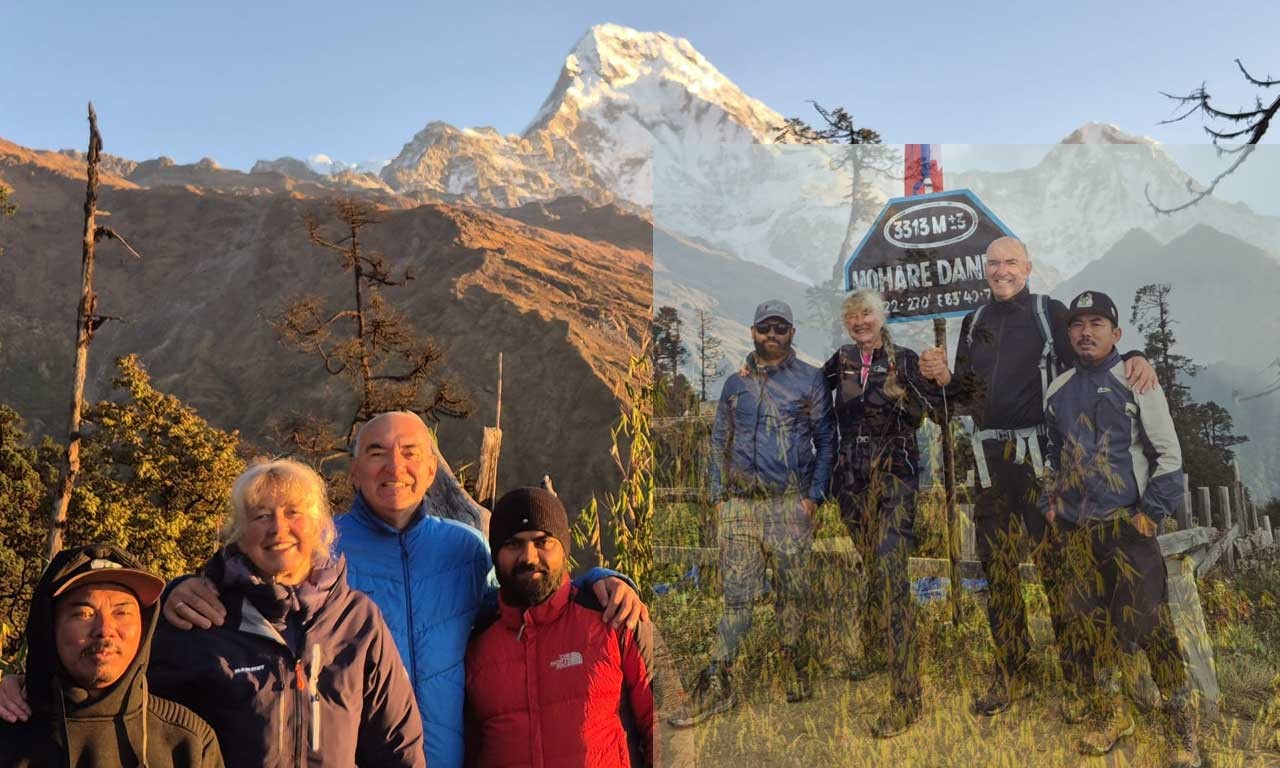There is no better trekking destination like the Annapurna Foothills in the Annapurna region starting from pokhara. Start every morning with the beautiful sunrise from the best viewpoints that we are covering in this trip plan. Simply put, the morning begins with the sunrise, the whole day with the magnificent views of the Annapurna ranges, and the day ends with the sunsets. This trek is the best choice for those who want to see the world’s tallest mountain peak without going higher. On this trek, you will see the Annapurna Ranges, Mt Dhaulagiri, Fishtail, Lamjung Himal Ranges, and many other peaks. The Annapurna Foothills Trek is a great choice for slow hikers, first-time trekkers, families, and those who are looking for a relaxing and scenic experience. The maximum height of the trek is 4200 m (13,779 ft), which is at the Mardi Himal Viewpoint. On this tea house trek, there are nice tea houses with great meals, hot showers, and great locations.
The Annapurna Foothills Circuit Trek Package can be customized according to your length of vacation. For the shortest treks that are already famous trekking routes in Nepal, such as Ghorepani, Mardi Himal, Khopra Danda, and Mohare Danda, we have combined all the best treks into one trip package. The Foothills Trek is moderately easy and offers an excellent experience for exploring majestic views, diverse landscapes, lush forests, beautiful villages, farmland, flora and fauna, and much more.
What are the location and viewpoints for the Annapurna Foothills Trek Package?
The Annapurna foothill's short treks are already a traveler's choice, as we mentioned earlier. On this Annapurna Foothills circuit trek, we cover the best viewpoints such as Mohare Danda, Ghorepani Poon Hill, Khopra Danda, Mulde or Muldai viewpoint, and Mardi Himal Viewpoint. For an idea about the location and views, you can play the Annapurna Foothills Trek package videos. We can add the Karbakeli Than Homestay trail to this itinerary, and it will be a tailor-made trip, so if you want to experience the Eco Homestay section of this trekking itinerary, let us know.
Annapurna Foothills Trek Cost
The 14-day Annapurna Foothills Trek starts from $985 USD per person for a group of two, reflecting our commitment to quality service and value for your investment in this incredible Nepal holiday. The final price is determined on a per-person basis and can vary depending on the total number of people in your group; typically, larger groups may receive a lower per-person cost. For a tailored itinerary or to get the most competitive offer for your specific needs, we recommend contacting our tour experts directly.
How challenging is the Annapurna Foothills Circuit Trek compared to other Annapurna treks?
It's important to understand that 'Annapurna Treks' refers to a vast region encompassing a variety of trails, from the highly challenging Annapurna Circuit, moderatly difficult Annapurna Base Camp treks to the relatively easy Ghorepani Poon Hill or short village excursions like Dhampus.
The Annapurna Foothills Circuit Trek is considered moderate in difficulty, making it accessible to people of most fitness levels. A significant factor contributing to its moderate rating is the minimal and gradual altitude gain throughout the journey. The trails are generally well-maintained.
Compared to the shorter and easier Ghorepani Poon Hill trek, the Annapurna Foothills Circuit Trek is indeed a bit more challenging due to its longer duration and the greater distance covered. However, this extended route also offers the significant advantage of exploring more of the Annapurna Region's excellent viewpoints and diverse landscapes.
Annapurna Foothills Trek outline trek itinerary.
- Day: 1 From Pokhara drive to Galeshwor and Trek to Bans Khakra 1526m ( 4 hrs walk – 6km)
- Day: 2 Bans Kharka Trek to Nangi 2300m ( 6 hours walk – 9 km)
- Day: 3 From Nangi Trek to Mohare Danda 3300m (6 hours walk – 8 km)
- Day: 4 From Mohare Danda Trek to Ghorepani 2880m ( 5 hrs walk -6km)
- Day: 5 From Ghorepani Trek to Swanta 2214m (6 hours walk 9 km)
- Day: 6 From swanta Trek to Khopra Danda 3660 m (7 hours walk – 13 km)
- Day: 7 From Khopra Danda Day Excursion to Khayer Lake (4660M) (optional rest or explore) 9 hrs – 11km)
- Day: 8 From Khopra Danda Trek to Dobato 2440 m ( 6 hours walk – 9km)
- Day: 9 From Dobato Trek to Tadapani 2630m (6 hours walk- 7km)
- Day: 10 From Tadpani Trek to landruk Village 1430 km ( 6 hours walk – 11km)
- Day: 11 From landruk Village Trek to Forest Camp 2500 m ( 6 hours walk – 6km)
- Day: 12 From Forest Camp Trek to High Camp 3580 m ( 6 hours walk – 7km)
- Day: 13 From High Camp Trek to Mardi Himal Base Camp 4500 M (14,764 ft) and Viewpoint and Trek to Badal Danda (7 hours walk – 9km)
- Day: 14 From Badal Danda Trek Siding and Drive to Pokhara. 827 m ( 5 hours walk – 9km)
What is the duration of the Annapurna Foothills Circuit Trek, and can it be shortened?
The Annapurna Foothills Circuit Trek can be completed in 14 days. However, we customized the trek plan as per your vacation schedule. The Trek days can be extended; let us know your travel ideas, and we will create a plan for you if you are looking for something different than the suggested trek plan. This complete trek route covers the below trekking routes.
- Mohare Danda Community Trek ( 5 days)
- Ghorepani Poon Hill ( 2 to 5 days)
- Khopra Danda Trek. (5 to 7 days)
- Mulde Viewpoint Trek (4 days)
- Mardi Himal Trek (3 to 5 days)
- Annapurna Panorama Trek (6 days)
Guided Annapurna Foothills Trek for 2025 and 2026
On this trek package, you can see the trek starting from Pokhara and ending in Pokhara, but if you want to start from Kathmandu and are looking for a complete package, let us know. Please let us know your estimated budget, or if you are part of a group, we can provide you with the group cost. The price normally includes all the necessary accommodations, transportation, meals, and permits. Additionally, if you have extra days and time, we can arrange paragliding, jungle safaris, and rafting activities.
What is the process for booking the Annapurna Foothills trek?
You can pay for your Annapurna Foothills Trek package online by following the booking link at the bottom of the page. Please write to us or contact us online if you have any questions or worries concerning the trip. We would be pleased to assist you in creating the ideal vacation. After completing your payment, kindly provide us with a scanned copy of your passport and a P.P.-size photo to facilitate the issuance of your trek permits.
What about the safety during the Annapurna trek?
The Annapurna Foothills Circuit Trek is safe. However, to assure you, we are aware of the acclimatization and the elevation changes. We have designed the Trek itinerary based on our research, and we are confident about the next steps and our destination. We suggest you drink plenty of water, and obviously, you will be eating a healthy diet. Our guides are aware of the conditions, and they will keep checking. Once you book the trek with us, we will send you the trekking gear list to prepare in advance.
What gear do I need for the Annapurna Foothills Circuit Trek?
- Bring a good pair of Trekking boots.
- Bring sunscreen, sunglasses, and a hat.
- Bring a rain jacket and rain pants.
- Bring a first-aid kit.
- Bring a water bottle and a water filter.
- Bring snacks and energy bars.
- Bring a camera.
- Bring a journal to record your memories.
For more details about the trekking gear, visit the link, which gives you clear information about the trekking gear which is needed for Nepal trekking.
What is the best time of year for the Annapurna Foothills Circuit Trek?
The Annapurna Foothills Circuit Trek is best undertaken in the spring (March–May) or fall (September–November). These months have warm weather and a lower likelihood of rain. However, many people think June to August is not a good time because of the rain, but during this time everywhere there will be greenery, rainbows after the rain, and beautiful wildflowers too. The best pictures were taken during the monsoon because the earth revives and there is greenery everywhere and the cloud's movements, and once the rain stopped, everything looked clear. You may also think what about trekking in Nepal Annpurna during the winter season? This trek is possible during the winter season as well but requires proper trekking gear.
What kind of accommodation can I expect on the Annapurna Foothills Circuit Trek?
On the Annapurna Foothills Circuit Trek, you can expect a range of comfortable accommodations, including proper hotels, lodges, and guesthouses. These typically provide clean rooms with warm blankets and pillows. In some specific locations, such as Ghorepani and Landruk, we can offer rooms with attached bathrooms. However, in most other places, bathrooms will be shared.
Hot showers are generally available everywhere, costing an additional $1 to $3 USD. Please note that while individual rooms do not typically have heating, the dining areas in lodges are traditionally warmed for your comfort. Purified, boiled, and mineral water are readily available for purchase throughout the trek.
Is the Annapurna Foothills Circuit Trek suitable for children?
Yes, the Annapurna Foothills Circuit Trek can be suitable for children. You may have seen or read stories of children successfully completing other treks like Everest Base Camp and Annapurna Base Camp. Based on our extensive experience and expertise in the Himalayas, we welcome children on this trek.
This trek is considered suitable for beginners, including children, because the route involves gradual ascents and descents each day, which can be less demanding. However, it's crucial to remember that walking in Nepal's mountain terrain, even on 'easier' routes, is not like walking on flat ground. Therefore, some physical preparation beforehand would be beneficial for everyone, not just children or beginners, to ensure a more enjoyable and comfortable experience.
What permits are required for the Annapurna Foothills Circuit Trek?
While the Trekkers' Information Management System (TIMS) card was previously mandatory for most treks in Nepal, recent regulations have made it no longer strictly necessary for treks within the Annapurna Conservation Area if you are accompanied by a licensed guide.
Here's a breakdown of what you need to know:
Annapurna Conservation Area Permit (ACAP): This is essential for anyone entering the Annapurna Conservation Area, which encompasses the Foothills Circuit.
Cost:
- Foreign Nationals: NPR 3,000 (approximately $25 USD)
- SAARC Nationals: NPR 1,000 (approximately $8 USD)
- Nepali Nationals: NPR 100
What wildlife can be seen on the Annapurna Foothills Circuit Trek?
The Annapurna Foothills Circuit Trek, situated within the biodiverse Annapurna Conservation Area, offers trekkers the opportunity to encounter a wide array of wildlife, from elusive mammals to vibrant bird species. While sightings are not guaranteed, the region is home to rare and endangered mammals such as the snow leopard, red panda, Himalayan tahr, musk deer, Himalayan black bear, and blue sheep, along with other species like leopards and langurs. Bird enthusiasts can also anticipate spotting a variety of colorful Himalayan pheasants and many other avian species, making it a rich environment for nature observation.
Why should you choose the Annapurna Foothills trek vs ABC?
While the Annapurna Base Camp (ABC) trek culminates in a breathtaking 360-degree amphitheater of towering peaks right at its heart, the Annapurna Foothills Circuit Trek offers a distinct advantage with its continuous and grand views from sunrise to sunset throughout the entire journey. Unlike ABC, where the most dramatic close-up panoramas are predominantly experienced upon reaching the base camp, the Foothills trek strategically traverses multiple celebrated viewpoints like Mohare Danda, Ghorepani Poon Hill, Khopra Danda, and Mardi Himal Viewpoint at varying, lower altitudes, ensuring a constant spectacle of the Annapurna, Dhaulagiri, and Machhapuchhre ranges unfurling across diverse landscapes every single day of the trek. This provides a more consistent visual feast, transforming each morning's awakening and every evening's descent into a vibrant display of Himalayan majesty.

